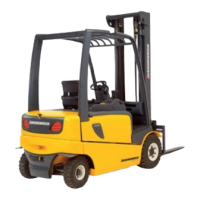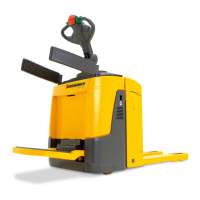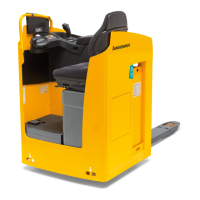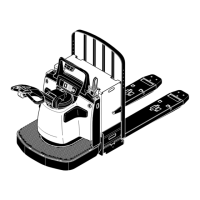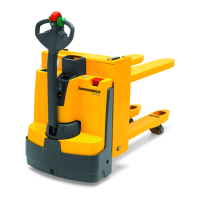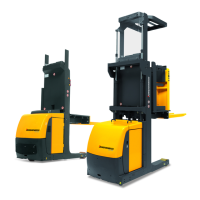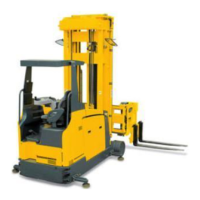Do you have a question about the Jungheinrich EFX 413 and is the answer not in the manual?
General instructions for operating the EFX 410/413 truck.
Explains the structure and scope of the operating instructions for different truck models.
Defines symbols used for safety instructions and explanations like DANGER, WARNING, CAUTION, NOTE.
Specifies that the truck must be used, operated, and serviced according to the instructions.
Details permitted operations and prohibited actions for safe truck usage.
Outlines the conditions under which the truck can be operated, including extreme conditions.
Defines the duties of the operating company for safe truck usage and adherence to guidelines.
Describes the EFX as an electric tri-lateral stacker designed for specific lifting and transport tasks.
Defines the directions of travel for the truck: left, drive, load, and right.
Details the truck's assemblies and their functions, including safety mechanisms.
Provides performance metrics like travel speed, lift speed, and traverse speed for EFX 410 and EFX 413.
Lists detailed dimensions of the truck, categorized by D, x, y, z, h1-h7, Ast, Wa, s, e, l, m1, m2, r.
Describes different mast designs, including telescopic and triplex stage masts with their technical data.
Details the basis truck weight including attachments and counterweights, without battery.
Provides information on tare weight and axle loads for EFX 410 and EFX 413 trucks.
Describes wheel specifications and chassis details for EFX 410 and EFX 413.
Lists output power for drive, lift, and steer motors.
Specifies noise emission levels in accordance with EN 12053.
Details weighted vibration acceleration on the seat and seat cushioning values.
Confirms truck adherence to electromagnetic emission and resistance limits.
Outlines operating conditions, including extreme conditions and ambient temperature/humidity limits.
Certifies manufacturer compliance with EN 1175 for electrical equipment design.
Shows and lists various indication points and labels on the truck for identification and warnings.
Explains the information contained on the truck's data plate, including type, serial number, capacity, and manufacturer.
Details how the capacity plate indicates the truck's capacity Q (kg) for an upright mast.
Explains how the attachment capacity plate indicates the truck's capacity in conjunction with the fitted attachment.
Indicates where the truck may be lifted and jacked up using the "Jack contact point" decal.
Details the two methods for transporting the truck, depending on mast height and local conditions.
Provides essential safety instructions and requirements for lifting the truck using a crane.
Outlines procedures and warnings for securely fastening the truck and mast during transport.
Covers initial setup and operations, including moving without a battery and mast installation/removal.
Describes the steps for preparing the truck for operation after delivery or transport.
Explains the function of the tilt safety device and its importance for truck stability.
Details critical safety regulations for handling lead-acid batteries, including maintenance personnel and fire protection.
Covers hazards associated with batteries and guidelines for using approved Jungheinrich batteries.
Lists available battery types for EFX trucks, including voltage and capacity, and relevant standards.
Addresses the impact of battery dimensions on truck stability and operational safety.
Explains how to open the battery panel and the safety precautions during this procedure.
Provides detailed safety procedures and warnings for charging the battery, emphasizing explosion hazards.
Outlines safety warnings and procedures for removing and installing batteries, including risks of trapping and short circuits.
Explains the function of "battery lock" sensors and how to operate the truck without battery locks.
Details driver authorization, operator rights/responsibilities, unauthorized use, damage reporting, and repair restrictions.
Emphasizes the importance of observing safety devices, signs, and instructions to prevent accidents.
Provides an overview of the truck's control panel and displays, identifying key components.
Explains the symbols and displays shown to the operator, including warning lamps and time/service hour indicators.
Explains how service hours are counted while the truck is operational.
Describes the bar display for battery discharge and potential damage from full discharge.
Explains the percentage display for battery charge status and its implications for operation.
Lists and explains various symbols used in the driver's display for attachment and fork operations.
Covers crucial checks and operations before starting daily truck use, emphasizing safety.
Provides instructions on how to safely enter and exit the truck.
Guides the operator on adjusting the seat and control panel for optimal ergonomics and safety.
Explains how to adjust the height of the control panel for better operator visibility and reach.
Details the procedure for adjusting the control panel horizontally.
Details the importance of seat belts and procedures for checking, wearing, and removing them.
Covers general safety regulations and considerations for operating the industrial truck.
Discusses the importance of a suitable travel surface for truck traction and stability.
Specifies requirements for ground conditions, including levelness, smoothness, and cleanliness.
Provides guidelines for safe travel speed, maneuvers, and communication while operating the truck.
Advises on maintaining clear visibility and using mirrors or lookouts.
Warns against negotiating slopes and inclines.
Warns against travelling on docks, dock plates, and loading platforms.
Prohibits towing trailers or other vehicles.
Provides guidelines for negotiating lifts with the truck.
Discusses national laws and restrictions regarding the use of work platforms.
Covers safe practices for carrying various types of loads, including liquid, suspended, and swaying loads.
Details the steps required to prepare the truck for operation, including visual checks and battery connection.
Explains how to set up and use additional access codes for truck operation.
Describes how to log off the user and what happens when the truck is abandoned.
Explains how to select the "Set Date/Time" menu and set the truck's date and time.
Lists essential checks and tests to perform while the truck is operational to ensure safety.
Explains the procedure for performing a reference run for the main lift to adjust height display and release truck operations.
Details the process for post-referencing the load handler after changes in its position or rotation.
Explains the function and safe usage of the emergency disconnect switch, warning against misuse.
Covers safe travel practices, modes of operation (FR, RG, WG), and collision hazards.
Describes steering operations inside and outside narrow aisles.
Details the three braking methods: coasting brake, brake pedal, and deadman button, and associated risks.
Provides critical safety instructions for entering and operating in narrow aisles, including hazards from objects and racking systems.
Explains how to perform diagonal travel, which involves simultaneous travel and lifting/lowering.
Covers accident risks associated with lifting and lowering operations, emphasizing hazardous areas and load safety.
Details safe practices for traversing and rotating, including risks of trapping and handling faulty attachments.
Addresses risks related to simultaneous traversing/rotation movements and handling attachments.
Provides instructions for safely parking the truck, including warnings about unsecured conditions.
Guides the operator on performing order picking and stacking operations.
Explains how to adjust fork spread and position for safe load handling, including warnings about unsecured loads.
Provides safety warnings and procedures for replacing fork tines, emphasizing injury risks and proper handling.
Covers crucial safety aspects for lifting, transporting, and depositing loads, warning about unsecured loads and persons.
Provides guidance on identifying and rectifying basic faults or operational errors.
Details the function of the automatic emergency stop and procedures for switching off the truck after activation.
Provides warnings and procedures for emergency lowering of the load handler, emphasizing risks of accidents and damage.
Explains the travel cutout override function and how to operate the truck with it deactivated.
Describes the automatic lift cutout function and how to override it, with warnings about extended masts.
Explains the automatic lower cutout function and how to override it, with warnings about load handler placement.
Details the function of the end of aisle safety device and procedures for continuing travel after braking.
Covers emergency operations for wire-guided trucks when the guide wire is lost or other faults occur.
Outlines procedures for recovering the truck from a narrow aisle or moving it without a battery, emphasizing risks and specialist personnel.
Explains how to release and activate the drive wheel brake for recovery operations.
Details how to steer the truck without its drive system when stationary, noting potential hazards.
Provides warnings and procedures for recovering the truck from a narrow aisle, emphasizing accident risks.
Covers procedures for recovering the truck in the load direction, with and without load.
Details procedures for recovering the truck in the drive direction, with and without load.
Details the Personal Protection System (PPS) and its components for ensuring operator safety.
Describes the PPS as an integrated system for protecting persons using laser scanner technology.
Explains the functional aspects of the PPS, including obstacle detection and standard functions.
Describes the meaning of various displays and LED signals from the laser scanner for the operator.
Outlines daily checks for the PPS, including cleaning and performing a cycle test.
Details how the PPS indicates obstacles or persons in warning and protection fields, affecting truck speed or stopping.
Lists and describes various optional equipment available for the truck.
Covers the functionality and operation of sideshifter and fork positioner attachments, including warnings.
Explains how to adjust fork spread using the fork positioner, noting that forks adjust simultaneously.
Discusses symmetric sideshift operation with an integrated fork positioner.
Explains the laser beam system for correct truck positioning relative to rack compartments.
Describes the use of telescopic forks for increased stacking depth and associated risks.
Details how user access codes affect the ability to display or change operator-specific settings.
Explains the function and operation of the fire extinguisher, including warnings about unsuitable extinguishing agents.
Describes the Rack Height Select function for pre-selected storage locations and associated display symbols.
Explains manual and automatic methods for entering area recognition zones.
Details how to enter rack numbers (lift height) using the numerical keypad for precise positioning.
Guides on approaching warehouse locations using Rack Height Select, with arrow indicators for lift adjustments.
Explains the general procedure and available options for stacking operations.
Describes how to perform manual stacking and retrieval operations based on driver display prompts.
Details automatic stacking using the hydraulic control lever in version A.
Details automatic stacking using the hydraulic control lever in version B.
Explains the symbols displayed for truck travel and fork adjustments in relation to destination requirements.
Lists common errors encountered during horizontal positioning and their corresponding descriptions and remedies.
Explains symbols displayed in the driver's display during storage mode for various attachment movements.
Details methods for entering warehouse destinations, including manual, barcode, and radio input.
Guides on manually entering area, rack row, location, rack height, and zone for destination.
Explains how to use a barcode scanner for destination input and potential manual fallback.
Covers automatic horizontal and manual vertical destination approach for stacking/retrieval.
Describes the optional weighing system and how it displays load weight.
Explains the tare function of the weighing system, which sets the display to zero.
Details the camera system's function as an aid for safe operation and how to use its monitor.
Discusses risks and regulations associated with using work platforms on industrial trucks.
Lists and describes the components of a work platform.
Provides procedures for safely lifting the work platform with the standard attachment.
Covers safety mechanisms and procedures for operating the truck while the person is in the work platform.
Details the procedure for safely lowering the work platform after use.
Describes the Floor-Spot as a visual aid for safety, projecting a light spot on the ground.
Lists the components related to the Floor-Spot assembly.
Explains when the Floor-Spot is activated or deactivated based on truck travel function.
Details Floor-Spot activation/deactivation during narrow aisle operations with rail or wire guidance.
Emphasizes performing inspections and maintenance tasks according to defined intervals and safety standards.
Outlines regulations for maintenance and repair personnel, including owner responsibilities and customer services.
Warns about using non-compliant wheels and describes wheel flattening due to long-term parking.
Stresses the hazard of faulty attachments and the need for daily checks and reporting defects.
Details procedures for inspecting lift chains for wear and damage, warning about risks from damaged chains.
Covers warnings related to leaky hydraulic systems and faulty hydraulic hoses, including injury risks.
Provides information on handling consumables safely and outlines the lubrication schedule.
Lists required consumables like hydraulic oil, grease, and cleaning agents with their order numbers and applications.
Covers preparations for maintenance and repairs, including switching off the truck and disconnecting the battery.
Provides critical safety instructions for lifting and jacking up the truck, warning against tipover risks.
Details the procedure for removing and reattaching the drive compartment cover.
Explains how to check electrical fuses, warning about risks of electrical current and incorrect fuse usage.
Lists fuse items, electric circuits, and their corresponding values (Amps).
Describes display statuses when the truck is switched off and on, indicating fuse status.
Provides instructions and warnings for cleaning the truck, emphasizing fire hazards and risks of component damage.
Guides on cleaning electrical system assemblies safely using air or suction, avoiding water.
Explains how to clean front screens of optical sensors, warning about potential damage from improper cleaning.
Refers to another section for cleaning the PPS laser scanner front screen.
Details lift chain servicing, including warnings about non-lubricated chains and hazardous solvents.
Explains how to lubricate lift chains and clean mast sections, highlighting risks of working at heights.
Provides crucial safety information and procedures for checking and adding hydraulic oil, warning about pressurised systems and overfilling.
Outlines the procedures required to return the truck to service after maintenance, including testing safety mechanisms and brakes.
Covers procedures for taking the truck out of service for extended periods, including storage and jacking requirements.
Details preparatory steps before decommissioning, such as cleaning, lubrication, and battery disconnection.
Provides a notice regarding battery discharge during decommissioning.
Lists steps for restoring the truck to service after decommissioning, including cleaning, lubrication, and brake testing.
Emphasizes the need for regular safety inspections and tests, and the operating company's responsibility for fault rectification.
Covers final decommissioning procedures and disposal regulations for the truck.
Explains human vibrations and the manufacturer's service for assessing application situations.
Lists standard maintenance tasks for EFX 410-413, including brakes and hydraulic operations.
Specifies the frequency for owner maintenance tasks, every 50 service hours or weekly.
Details points to check for standard equipment, including electrical, power supply, travel, chassis, hydraulic, and steering systems.
Outlines maintenance tasks to be performed by customer service at specified intervals, including brakes, electrical systems, and travel.
Describes testing of Horizontal Positioning (HozPos) functions like Emergency Stop and positioning accuracy.
Lists inspection points for optional equipment such as JH personal protection system, aisle recognition, and load sensing.
Checks the secure seating and function of the access module and for damage.
Specifies correct usage and warns against unauthorized repairs or parts that invalidate the warranty.
Explains the components of the battery data plate, including model, serial number, voltage, capacity, and manufacturer.
Details safety precautions for handling batteries, including hazardous waste disposal and fire/explosion hazards.
Describes Jungheinrich traction batteries (PzS, PzB, PzS Lib, PzM) and electrolyte properties.
Covers battery commissioning, discharging, and charging procedures.
Provides daily, weekly, monthly, and annual servicing instructions for sealed lead-acid batteries.
Describes the design of the Aquamatik system for automatic electrolyte level adjustment.
Explains the function of electrolyte circulation during charging to mix electrolyte and prevent gas formation.
Details procedures for cleaning batteries and trays to maintain cell insulation and prevent damage.
Provides guidelines for storing batteries to maintain functionality, including charging recommendations.
Guides users on how to identify and resolve faults with batteries or chargers.
Covers proper disposal methods for batteries, emphasizing recycling and avoiding household waste.
| Brand | Jungheinrich |
|---|---|
| Model | EFX 413 |
| Category | Trucks |
| Language | English |

